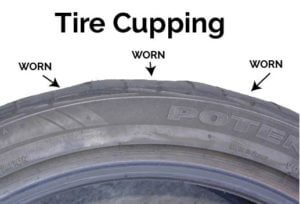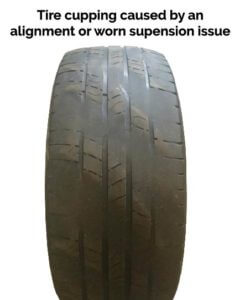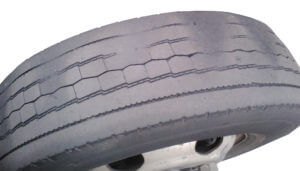Tire cupping
What is tire cupping and what causes it?
Tire cupping is a tread wear condition when portions of the tire tread have been worn away in a scalloped or scooped pattern. Tire cupping causes excessive noise when driving at higher speeds and can cause a rough ride at slow speeds. The root cause of tire cupping can be fixed,  but once a tire is severely cupped, the damage is done and the tire must be replaced. You can rotate the tires after the repair, but the noise will remain until the tread wears down past the tire cupping area.
but once a tire is severely cupped, the damage is done and the tire must be replaced. You can rotate the tires after the repair, but the noise will remain until the tread wears down past the tire cupping area.
Tire cupping causes
Tire cupping can be caused by low quality tires, out-of-round tires, an out-of-balance problem (tire or wheel), vehicle alignment, control arms, bushings, bearing or shock absorber/strut wear issues. Let’s take a look at how each component causes tire cupping.
• Tire balance/out-of-round causes tire cupping—When a tire is out-of-round or the tire/wheel isn’t balanced, the high or heavy point will lift off the road slightly with each rotation. The lifting becomes worse as vehicle speed increases, causing the tire to bounce and slow while it’s in the air. Each time it returns to the pavement, the tire scuffs as it regains speed, just like airplane tires do when they contact the runway during landing. The tire loses a small amount of rubber during each scuff, causing the out-of-balance condition to get even worse and cause more severe scuffing.
• Worn shocks/struts—The main job of a shock absorber is to dampen spring oscillations and reduce tire bounce. When shock or struts wear to the point where they can no longer dampen spring oscillations, the tire bounces excessively, causing the same type of scuffing as would be caused by an out-of-round or out-of-balance tire. Shocks/struts have a limited lifespan of around 80,000 miles, depending on the type of roads you drive.
• Alignment—Tire cupping occurs when the front and rear axles aren’t  parallel with one another. This can happen when the front toe angles are off. Diagonal tire cupping occurs when the rear wheels on a FWD vehicle aren’t perfectly aligned with the front wheels. That causes the rear tires to be dragged at an angle which causes them to hop. each hop causes the tire to lift off the road and hit again as it contacts the pavement. Since the tire is at an angle to the front wheels, the cupping is also at an angle.
parallel with one another. This can happen when the front toe angles are off. Diagonal tire cupping occurs when the rear wheels on a FWD vehicle aren’t perfectly aligned with the front wheels. That causes the rear tires to be dragged at an angle which causes them to hop. each hop causes the tire to lift off the road and hit again as it contacts the pavement. Since the tire is at an angle to the front wheels, the cupping is also at an angle.
• Control arms, bushings or bearings—Each of these components plays a part in keeping the tires rotating in the same plane. If they wear, the tire pushes slightly sideways when rolling (like walking with your toes pointing  inward). That causes the tread block to feature slightly and snap back into position as they roll off the pavement.
inward). That causes the tread block to feature slightly and snap back into position as they roll off the pavement.
For more information on shocks and struts, read this post.
©, 2016 Rick Muscoplat
Posted on by Rick Muscoplat